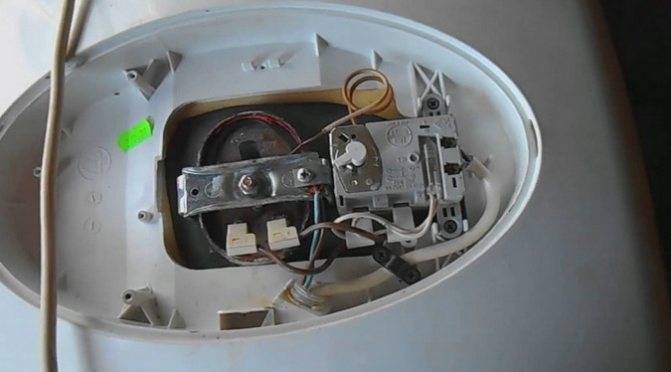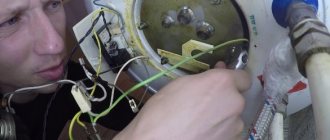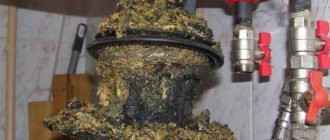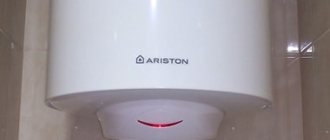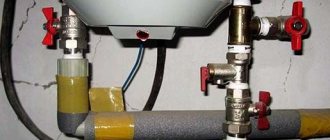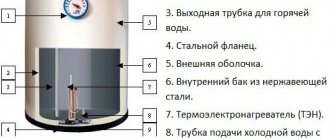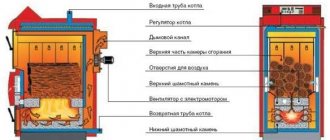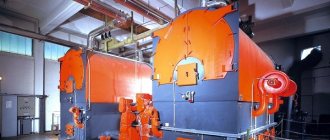What tasks do heating elements perform?

Water heaters with "dry" and "wet" heating elements
The heating element for the Ariston water heater can be "dry" or "wet" and they differ from each other in the principle of their location. "Dry" products are in demand, as they are placed in a protective casing, due to which contact with water is excluded.
Such heating elements have their own characteristics:
- longer service life;
- longer water heating;
- higher cost.
Since "dry" heating elements are at the stage of development, there are several variations of them.
- The simplest and most common option is when the heating element is placed in a flask. Such a product has a minimal cost and does not cause difficulties in replacement.
- There is a mechanism, the flask of which is filled with quartz sand. This option is easier to replace.
- There are also products where the flask and the heating element have a layer of oil between each other. Since oil has a higher thermal conductivity than air, this product achieves maximum energy savings.
Using a dry heating element for the Ariston boiler, the appearance of electric potential in the water is minimized, which makes the operation of the heater practical and safe.
There is also a heating element for "wet" type aristones.
The open element is in contact with the liquid in the storage tank. There is quartz sand or magnesium oxide inside the tubes of the heating mechanism. These substances conduct heat efficiently.
Open-type heating elements are classified according to the following technical characteristics:
- Is there an anode socket. A heating element with a nut may not be equipped with an anode fastener or have it as an additional one - a retainer on the flange.
- What is the mounting method. The element can be fastened with flanges and nuts. Flanged heaters are manufactured using casting or stamping technology.
- The shape of the heating element depends on the type of storage tank. Can be straight or curved to either side.
Stainless steel and copper are commonly used to make a wet appliance.
The heating element for the Ariston water heater is produced by an Italian company. For manufacturing, an alloy of copper and chromium-nickel is used. Thanks to the brass flange, the device has a high heat dissipation. The power depends on the model, but varies from 1 to 4.5 kW.
https://youtu.be/z0cfuNN-FCQ
How to choose the right mechanism
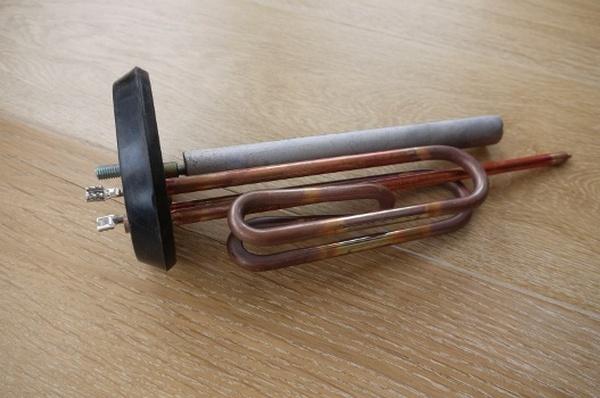

Heating element for boiler Ariston
How the designation of heating elements is read, for example, heating elements - 32 A 13 / 1.5 J 220 where:
- TEN - tubular electric heater.
- 32 - the unfolded length of the heating element along the shell.
- A - designation of the termination of the contact rod.
- 13 - the diameter of the heating element shell.
- 1.5 - rated power in kW.
- J - designation of the medium for heating and the material of the heating element
- 220 - rated voltage in V.
If you navigate in the marking, you can find the desired model quickly and without unnecessary nerves. And for this you do not need to walk with a centimeter or carry a broken product with you. It will be enough to compare the data on your heating element and the one you are going to buy.
When choosing a heating element for the Ariston boiler, you should pay attention not only to the price, but also to the structural differences. It is also necessary to consider the performance characteristics of electric heaters.
Having a stable voltage and proper operating conditions, a "wet" heating element will last an average of 5 years, and a "dry" one - 15.
The company recommends purchasing equipment for replacement in factory-made water heaters and according to the available model of the unit.
TENs with a capacity of 1.5 kW are more common for Ariston boilers. They are often used in both 20 liter and 100 liter equipment.
Engineers strongly advise against replacing a low-power heating element with a more efficient one, since the water in the equipment heats up to 85 degrees and the boiler turns off. And high power disrupts the operation of the device and increases the cost of each water heating.
When choosing a heating element, you should also pay attention to the flange. Threaded - thanks to the existing thread, the heater is attached to the boiler by screwing it in. The thread diameter is 1 1/4 inch. Clamps - there are such diameters: 62 mm, 72 and 82 mm.
For dry heating elements - they are made of enameled metal, almost always paired, they have divorced close-set contacts with a "petal" type mount.
Step-by-step instructions for replacing an electric heating element
The entire procedure for replacing the heating element in the boiler must be approached with accuracy and caution. To avoid damage to other parts, it is recommended that you study the entire manual in detail before servicing the equipment.
Reasons for repairing a water heater:
- The water is not heated.
- Long time waiting for water heating.
- Frequent on / off.
- Cloudy water with an unpleasant odor.
Depending on the model, the heating element fastening in the boiler is presented in three types: a large nut size 55, a clamping bar and a flange with fastenings in a circle.
Replacing a heating element in a boiler with a fastening nut 55
At the initial stage of repair work, it is necessary to de-energize the equipment. Shut off the cold water supply with a shut-off valve and only then proceed to disconnect the pipes or flexible hoses supplied to the boiler. Having prepared the container and hose in advance, unscrew the connection of the water supply system with a wrench together with the boiler safety valve. In this way, a faster drainage of water is ensured. Lead the hose into the drain and put it on the threaded part, after placing the container under the water heater.
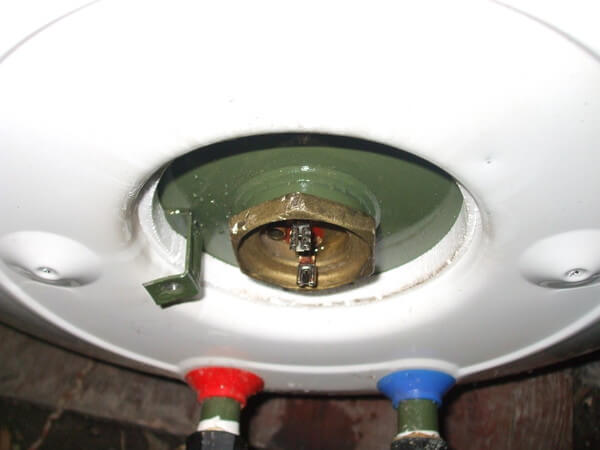

Water heater with fastening nut for 55
After there is no water left in the boiler, the next step is to remove the protective case. By unscrewing the two screws for a cross-section screwdriver, the bottom cover of the water heater is removed. Under the protective casing is the electrical connection to the heating element and the thermostat. The outer part of the entire construction of the water heater is located in the same place, in the form of a fastening nut.
Before disconnecting the terminals of electrical wires from the automation, it is necessary to fix their correct connection. Can be photographed or transferred to paper with the exact indication of the connection (wires are usually of different colors).
All nuts are unscrewed counterclockwise and, if necessary, the boiler can be removed from the wall and turned upside down, then proceed to disassembly.
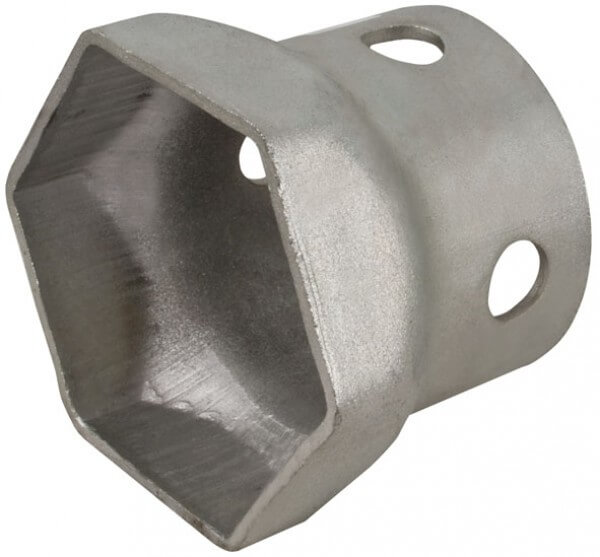

Hub key 55
With a gas wrench No. 2 or a hub wrench with a size of 55, carefully turn, unscrewing the nut. It is quite possible that during the use of the water heater, a large amount of scale has formed on the heating element, which does not allow pulling out the heating element. To do this, it is necessary to knock down the growths a little with a non-sharp object.


Complete heating element with magnesium anode and thermostat
Before installing a new heating element, you should pay attention to the state of the magnesium anode. In most cases, the protective element is completely destroyed, where instead of the anode there is only a threaded rod on which it is held. The magnesium anode is purchased separately and is the basis for the quality and duration of the heating element. Before purchasing a protective element, you must make sure of the exact diameter of the threaded connection and the thread pitch by screwing the rod into the place provided for it.
Required tools: gas wrench # 2, hub wrench, positive screwdriver.
Replacing a heating element in a boiler with a fastening bar
In more modern boilers, where a clamping bar protrudes instead of a fastening nut, the internal structure will be slightly different.
All sequential actions up to the moment of untwisting the main nut are carried out in a standard manner. Also de-energize and shut off the water, remove the protective cover and fix the correct connection of the electrical wires and disconnect them.


Unscrewing the bolts securing the protective housing
An important and main rule when disassembling this type of boiler is the inability to turn the water heater over. The electric heating element is fixed on the main nut so that when unwinding it will fall inside, damaging the inner wall of the water heater. Therefore, all replacement and maintenance work should be carried out only in the standard position of the water heater.
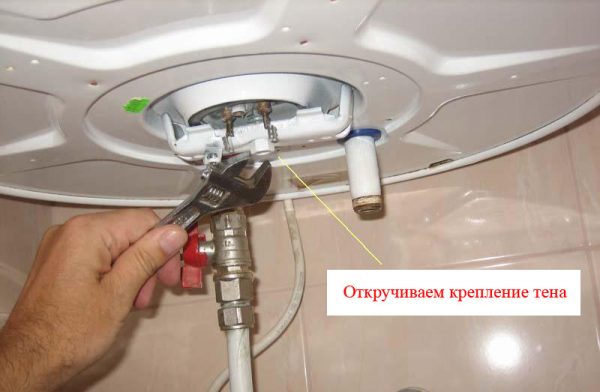

Boiler model with one nut and fixing bar
The thermostat can be removed in the same way as in any Ariston water heaters. Disconnect the thermometer from the entire structure with a sharp movement.
The main nut is pulled to the fastening bar, by unscrewing which you can get the flange with the heating element. Before pulling out the flange, you need to swing and rotate it a little.
Installation and connection methods
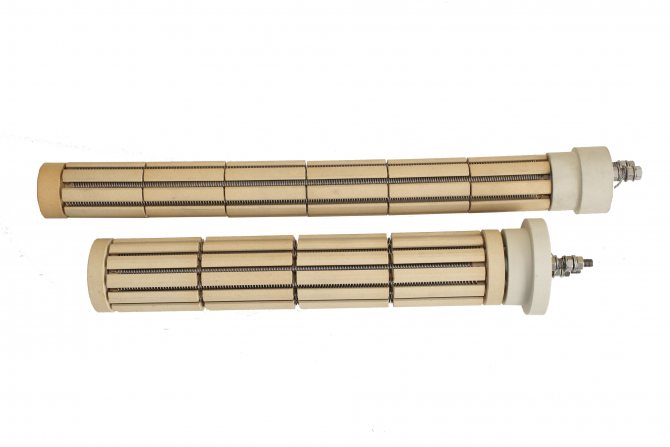

"Dry" heating element
Teng is a device that requires regular maintenance. After a while, it needs to be cleaned or replaced, depending on the efficiency and completeness of the work.
To clean the heating element yourself, you need to follow the instructions:
- Turn off the electric water heater.
- Disconnect the electric heater from the power supply.
- Open the cover by unscrewing the screws.
- Disconnect the cables under the panel where the thermostat and colored wires are located.
- Shut off the water supply to the water supply system and boiler.
- Pull out the thermostat together with the heating element, removing the flange if necessary. In this case, substitute a container to the opening in case there is water in the tank. Unscrew the heating element with an adjustable wrench.
- Dissolve two packets of citric acid in two liters of water.
- Immerse the heating element in the resulting solution and leave for at least 12 hours. After a while, the heating element is ready for installation.
- Install in reverse order.
To check the correct installation of the heating element, you will need to turn on the water. If fluid leaks from the tank, the device is not properly connected.
Several heaters can be installed in the boiler, depending on the power of the unit. The power, in turn, may depend not only on the heating element, but also on the way it is included in the system.
There are three main ways to connect the heating element for the Ariston water heater. Sequential - the power of the heater depends on the total power of each element. The disadvantage is that if one heating element breaks down, the performance of the entire heating system is lost.
Parallel - allows you to maintain the unit's performance in the event of failure of one of the heating elements. Combined - usually used if there are no heating elements of the required power.
How to drain water from a boiler: instructions


Boiler water supply taps
Disassembling and cleaning the electric tank is not difficult, but the device itself is heavy. Therefore, it is better to remove it with another person who will help and support the device during dismantling. Here are instructions on how to drain the water from the boiler:
- Disconnect the device from the mains, remove the plug from the socket.
- Disconnect the cold water hose from the water pipe and lower it into any container (basin, bath, and so on). The hot water pipe does not need to be touched.
- Put the hose that you removed over the safety valve. Dip the free part of the hose into a container.
- Open the taps of the device, and release the check valve fuse.
- Open the hot water taps in the bathroom and kitchen. First, you will hear a sound as if the tank is drawing in air, and then the liquid that was in the device will be ejected. For this, it was necessary to lower the hoses into the container.
- After all the liquid has drained out, blow out the cold water hose with air. If there is no gurgling, you can continue on.
Recommended: Choosing an ironing board for a steam generator
Now unscrew the hose that supplies hot water to the mixer. Remove the boiler from its place and place it on the floor with the taps up. Proceed to the next step of dismantling.
The main types of breakdowns


"Wet" heating element
When operating electric storage-type water heaters, technical questions often arise about the performance of a particular part. But the most common problems are breakdowns of the heating element, which, under the influence of external and internal factors, tends to fail.
Signs of a heating element malfunction:
- knocks out the safety switch of the electrical network;
- heater cut-out fuse trips;
- the tap water flows cloudy and has an unpleasant odor;
- the unit works loudly: hiss, crackles, etc .;
- the outlet water is cold;
- the device is constantly switched on and off.
Each of these signs indicates that the heater is not working properly. In this case, it should be replaced as soon as possible. As a rule, this restores the operation of the unit.
If the replacement of the heating element did not correct the situation, then in this case, you should contact the specialists for the warranty card. If its term has expired, then you will need to find a proven service center, where you can establish the cause of the breakdown and eliminate it as soon as possible.
Tips for disassembling the structure and cleaning the wet heating element
Before cleaning the boiler begins, the device must be disassembled by pulling out the heating element. To do this, first remove the decorative plate that covers the contacts and the place where the element is attached. It can be screwed on or latched on. Having reached the internal elements, it is recommended to photograph them so that there are no problems with the subsequent recovery of the system.
We disconnect all contacts, after which we take out the heating element. If the device has not been descaled for a long time, proceed very carefully. Accumulated dirt may prevent the heating element from being easily removed. You do not need to pull it, it is better to try to carefully clean the deposits.
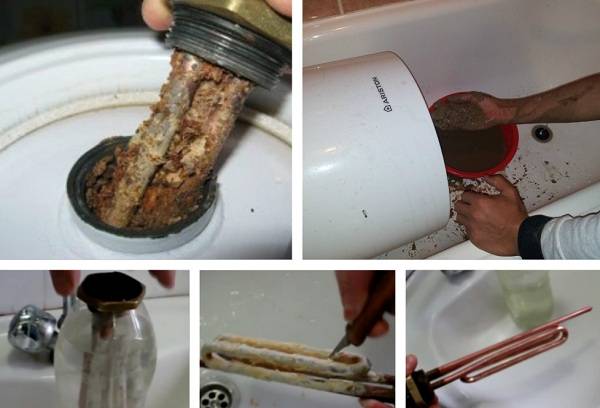

Tip: Having reached the insides of the structure, it is recommended to assess the condition of the magnesium anode. If it is severely thinned, then it should be replaced without waiting for the element to fail.
In most cases, scale layers are collected on the tubular part, and there is not much of it inside the tank. It is enough to turn on the water to wash everything unnecessary from the boiler itself. If you cannot clean the boiler in this way, you will have to work with your hands. The main thing is not to try to facilitate the process by using aggressive abrasives. You need to use only proven safe means.
To clean the heating element itself from the scale layer, it is necessary to carry out the following manipulations:
- We clean off the main part of the dirt mechanically using a knife or something similar.
- Next, dilute citric acid in a tall glass made from a plastic bottle (just cut off the neck). For 2 standard sachets of powder, about 2 liters of warm water.
- We place the heating element in this structure for at least a day. This time will be enough for all the dirt to come off, and the heating element returns to its original form.
We recommend: How to descale a humidifier
After carrying out these manipulations, you can assemble the boiler, test it and subject it to further operation.


Customer Reviews
Sergey, Moscow: “We bought an Ariston SG-100 boiler in 2020. According to its pricing policy and minimal functionality, it is pretty good. Copes with water heating perfectly. The temperature is set using a thermostat, which is located under the protective cover.Initially, it seemed to us that this method is not very convenient, since to remove the cover you need to unscrew two bolts. But in the course of operation, it turned out that this was not a problem. Moreover, the water temperature is regulated twice a year: in spring and autumn. I think a small feature is the absence of a plug for connection. This unit is connected to the network through a 16A automatic machine. "
Vladimir, Moscow: “Installed a water heater Ariston 7 years ago. Worked great. Three years later, the mother-in-law installed the same. I'm also happy. But after 6 years of service, the heating element burned out. I decided to change it myself. It turned out that there is nothing complicated about it. The heater itself bought a branded one, as I read negative reviews about unknown manufacturers. The heating element has been working normally for 1.5 years already, I hope it will continue to be so for at least 4 years. "
